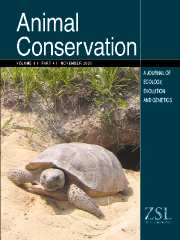Crossref Citations
This article has been cited by the following publications. This list is generated based on data provided by
Crossref.
Sommer, S.
2003.
Effects of habitat fragmentation and changes of dispersal behaviour after a recent population decline on the genetic variability of noncoding and coding DNA of a monogamous Malagasy rodent.
Molecular Ecology,
Vol. 12,
Issue. 10,
p.
2845.
Sommer, S.
2005.
Major histocompatibility complex and mate choice in a monogamous rodent.
Behavioral Ecology and Sociobiology,
Vol. 58,
Issue. 2,
p.
181.
Sommer, Simone
2005.
The importance of immune gene variability (MHC) in evolutionary ecology and conservation.
Frontiers in Zoology,
Vol. 2,
Issue. 1,
Goodman, Steven M.
Andriafidison, Daudet
Andrianaivoarivelo, Radosoa
Cardiff, Scott G.
Ifticene, Edina
Jenkins, Richard K. B.
Kofoky, Amyot
Mbohoahy, Tsibara
Rakotondravony, Daniel
Ranivo, Julie
Ratrimomanarivo, Fanja
Razafimanahaka, Julie
and
Racey, Paul A.
2005.
The distribution and conservation of bats in the dry regions of Madagascar.
Animal Conservation,
Vol. 8,
Issue. 2,
p.
153.
Goodman, Steven M.
Vasey, Nathalie
and
Burney, David A.
2006.
The subfossil occurrence and paleoecological implications of Macrotarsomys petteri (Rodentia: Nesomyidae) in extreme southeastern Madagascar.
Comptes Rendus Palevol,
Vol. 5,
Issue. 8,
p.
953.
Langhammer, Penny F.
2007.
Identification and gap analysis of key biodiversity areas: targets for comprehensive protected area systems.
Young, Richard P.
Volahy, Anselme Toto
Bourou, Robert
Lewis, Richard
Durbin, Joanna
Wright, Tim J.
Hounsome, Tim D.
and
Fa, John E.
2008.
A baseline estimate of population size for monitoring the Endangered Madagascar giant jumping rat Hypogeomys antimena.
Oryx,
Vol. 42,
Issue. 04,
p.
584.
van Vuuren, B. Jansen
Woolaver, L.
Goodman, S. M.
and
Reed, David
2012.
Genetic population structure in the boky‐boky (Carnivora: Eupleridae), a conservation flagship species in the dry deciduous forests of central western Madagascar.
Animal Conservation,
Vol. 15,
Issue. 2,
p.
164.
Winternitz, Jamie C.
and
Wares, John P.
2013.
Duplication and population dynamics shape historic patterns of selection and genetic variation at the major histocompatibility complex in rodents.
Ecology and Evolution,
Vol. 3,
Issue. 6,
p.
1552.
Young, R.P.
Hudson, M.A.
Terry, A.M.R.
Jones, C.G.
Lewis, R.E.
Tatayah, V.
Zuël, N.
and
Butchart, S.H.M.
2014.
Accounting for conservation: Using the IUCN Red List Index to evaluate the impact of a conservation organization.
Biological Conservation,
Vol. 180,
Issue. ,
p.
84.
Zinner, Dietmar
Wygoda, Christian
Razafimanantsoa, Leon
Rasoloarison, Rodin
T. Andrianandrasana, Herizo
Ganzhorn, Jörg U.
and
Torkler, Frank
2014.
Analysis of deforestation patterns in the central Menabe, Madagascar, between 1973 and 2010.
Regional Environmental Change,
Vol. 14,
Issue. 1,
p.
157.
Radchuk, Viktoriia
Oppel, Steffen
Groeneveld, Jürgen
Grimm, Volker
and
Schtickzelle, Nicolas
2016.
Simple or complex: Relative impact of data availability and model purpose on the choice of model types for population viability analyses.
Ecological Modelling,
Vol. 323,
Issue. ,
p.
87.
Hayes, Loren D.
Ebensperger, Luis A.
Kelt, Douglas A.
Meserve, Peter L.
Pillay, Neville
Viblanc, Vincent A.
and
Schradin, Carsten
2017.
Long-term field studies on rodents.
Journal of Mammalogy,
Vol. 98,
Issue. 3,
p.
642.
Miszkiewicz, Justyna J
Louys, Julien
Beck, Robin M D
Mahoney, Patrick
Aplin, Ken
and
O’Connor, Sue
2020.
Island rule and bone metabolism in fossil murines from Timor.
Biological Journal of the Linnean Society,
Vol. 129,
Issue. 3,
p.
570.
Santini, Luca
Benítez‐López, Ana
Dormann, Carsten F.
and
Huijbregts, Mark A. J.
2022.
Population density estimates for terrestrial mammal species.
Global Ecology and Biogeography,
Vol. 31,
Issue. 5,
p.
978.
Yousefi, Masoud
Mahmoudi, Ahmad
Kafash, Anooshe
Khani, Ali
and
Kryštufek, Boris
2022.
Biogeography of rodents in Iran: species richness, elevational distribution and their environmental correlates.
Mammalia,
Vol. 86,
Issue. 4,
p.
309.
Ramsay, Malcolm S.
Sgarlata, Gabriele M.
Barratt, Christopher D.
Salmona, Jordi
Andriatsitohaina, Bertrand
Kiene, Frederik
Manzi, Sophie
Ramilison, Miarisoa L.
Rakotondravony, Romule
Chikhi, Lounès
Lehman, Shawn M.
and
Radespiel, Ute
2023.
Effects of Forest Fragmentation on Connectivity and Genetic Diversity in an Endemic and an Invasive Rodent in Northwestern Madagascar.
Genes,
Vol. 14,
Issue. 7,
p.
1451.
Youk, Seungyeon
Kang, Mingue
Ahn, Byeongyong
Koo, Yangmo
and
Park, Chankyu
2023.
Genetic Diversity and Sequence Conservation of Peptide-Binding Regions of MHC Class I Genes in Pig, Cattle, Chimpanzee, and Human.
Genes,
Vol. 15,
Issue. 1,
p.
7.


